Galatopita, Greek milk custard pie
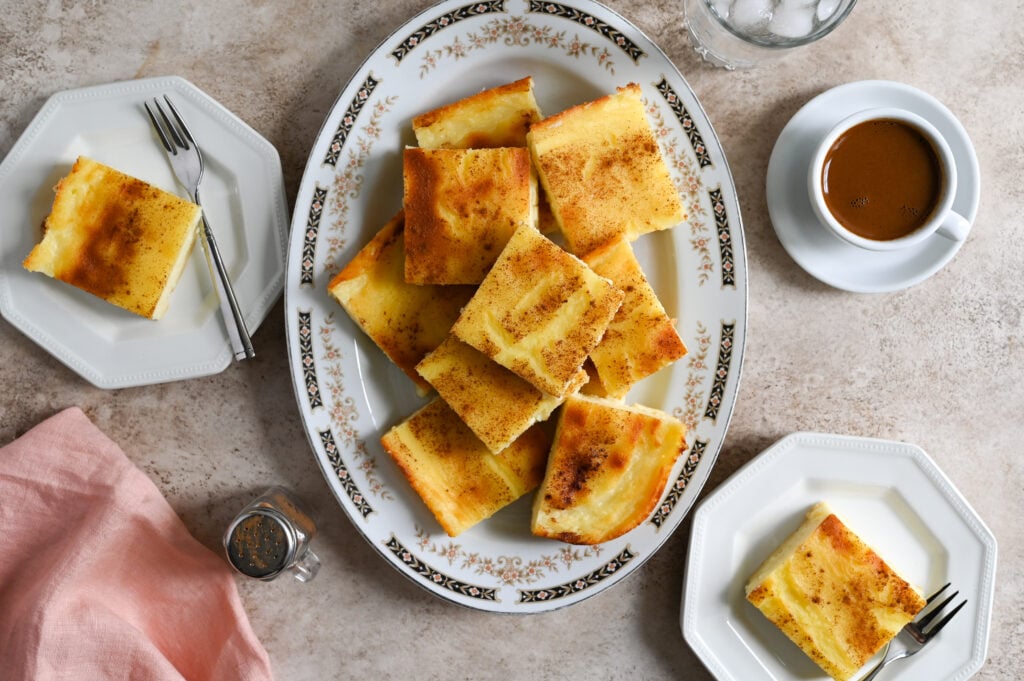
Galatopita (or galopita) is a Greek milk custard pie made without phyllo or crust
Γαλατόπιτα. Galatopita (sometimes called galopita) is a traditional Greek milk custard pie that is popular in the Peloponnese region of Greece, made especially during Easter. There are several variations, including those with phyllo and those without. If you have ever tasted a great galatopita you would remember its richness, sweetness and unique texture. You may also remember sneaking a few extra pieces after your initial one, how the kitchen smells when it’s baking, and how amazing it tastes right out of the fridge. Galatopita reminds us of all these things, but most of all it reminds us of Helen’s godmother.
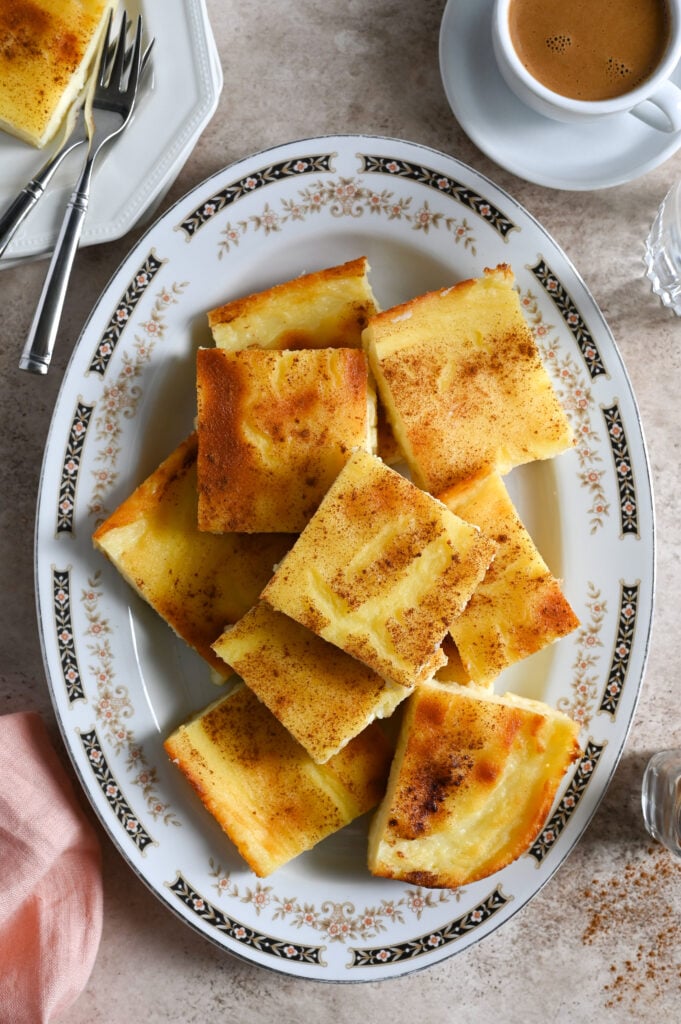
Our parents never made galatopita; in our family this dessert was the specialty and trademark of one of their dearest and closest friends. Koumbara Dina, as she was referred to by everyone (except Helen who was privileged to call her Nouna) was a wonderful cook, a real νοικοκυρά (homemaker), and she was happiest when she was caring for and feeding her husband and two daughters, and anyone else who happened to pop by.
If you don’t come from a Greek family, then there are a few things we ought to clarify about Greek families. Specifically, what is a Koumbara? In traditional Greek wedding ceremonies there are four roles which are critical. You must have the couple, obviously. You also need a priest, and you need a Koumbaro or the female equivalent, Koumbara (or both – Koumbari!). You can have ring bearers and ushers and little puppies wearing bowties leading the bride down the aisle, but without at least one Koumbaro the wedding cannot go on. The Koumbaro acts as the wedding sponsor and during the ceremony they exchange the wedding crowns and the wedding rings. Another way to become a Koumbaro or Koumbara to parents is to baptise their child. You are Koumbara to the parents, and Nouna to the child.
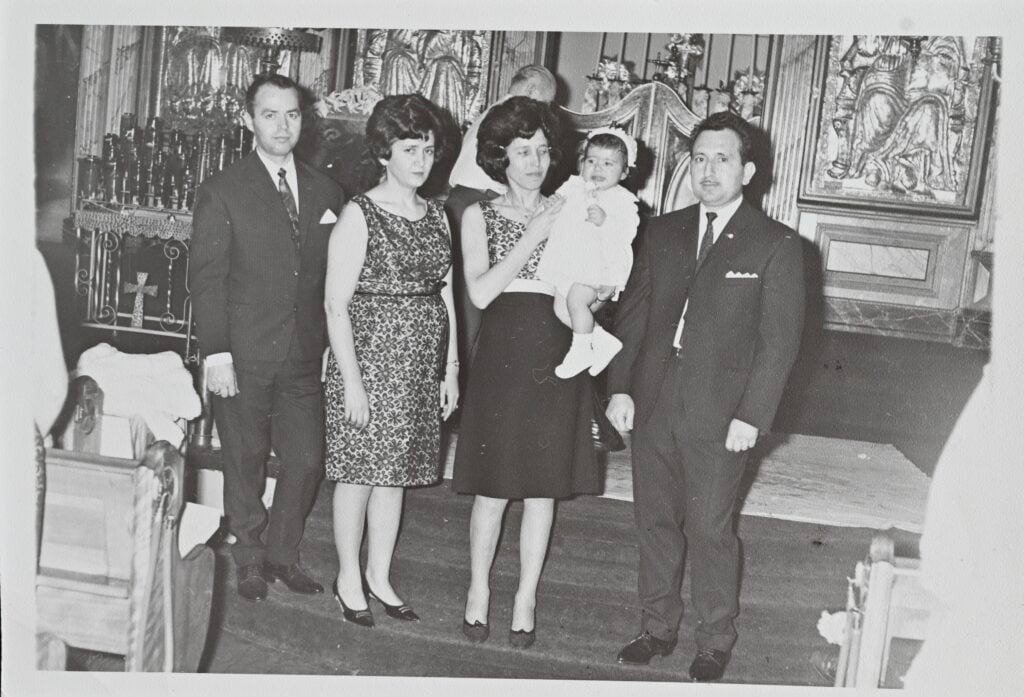
Whether it is through a marriage or a baptism, becoming a Koumbaro to a couple is a big deal; so much so that when people decide to enter into this relationship they say κάνουμε κουμπαριό (we are becoming Koumbari). It signifies the commitment to a relationship recognized by God, and it implies that a friendship has moved into the realm of family. This relationship is so important that it trickles down to the entire family. So, if Mary is the Koumbara at your wedding, Mary’s sisters, her brothers, her parents, her grand-parents and sometimes even her cousin twice removed (if you like him) are referred to as your Koumbari as well. In turn, you are also referred to as Koumbara by all of them.
Our parents were fortunate and blessed with many wonderful Koumbari, people that they shared so much with over the course of their lives. It’s humbling to remember that as first generation immigrants to Canada, our parents and their friends shared many of the same challenges and struggles, and triumphs. They were connected by similar roots and relied on one another for everything. Much of our parents’ family remained in Greece, as was the case for many of their friends, so these friendships filled important voids created by the absence of parents, siblings and cousins, and they lasted for years, and years.

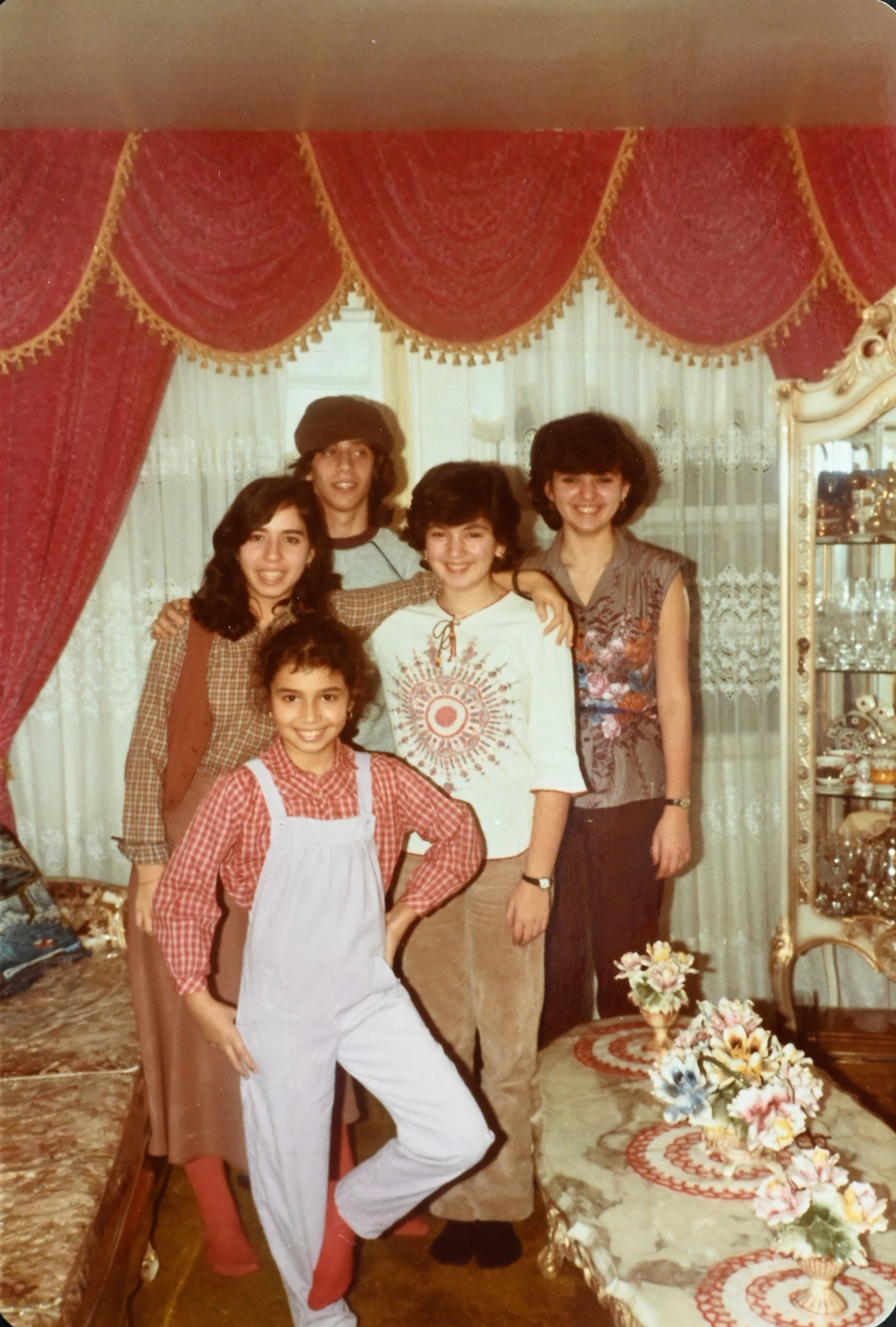
Our parents’ relationship with Helen’s godparents was particularly special. They never lived far apart, whether it was in the same apartment building, or a few blocks away, they were close enough that visits were frequent. We remember a time when practically every Friday and Saturday evening was spent either at their house or ours. The grown-ups would spend the evening talking, laughing, cooking, eating and doing needlepoint. So much needlepoint! This was all the rage at that time, and as a result our homes were filled with ornately framed and colourful embroidered canvases.

While the adults adulted, we would spend time with Helen’s godsisters, Alexandra and Fotini. What amazing times we had, growing up together. We saw each other through high school, Greek school, and σχολή της νοικοκυράς (the still-laughed about homemaker school that Helen, Fotini and Alexandra got enrolled in). We lived through Farah Fawcett hair, corduroy jumpers and blue eyeshadow. There were hours spent playing board games, going for walks, or just hanging out. Our families vacationed together, went to church together and celebrated every milestone, together. Our lives were intertwined and we wouldn’t have had it any other way.

Often when we would gather, Helen’s Nouna would make galatopita, the classic Greek milk custard pie. Firm enough to be picked up with our fingers she would come around with a beautiful platter, piled high with pieces of galatopita, and offer us a piece. This amazing milk custard pie was the perfect treat to have while watching a hockey game, playing Monopoly or dancing along to MTV music videos (there was a particularly epic Like A Virgin choreography that we are thankful cellphones weren’t around for). When hosting a larger party, she would set out two platters of galatopita; one for the dessert table, and one in the living room next to where people sat so that they could snack easily, whenever the urge struck.
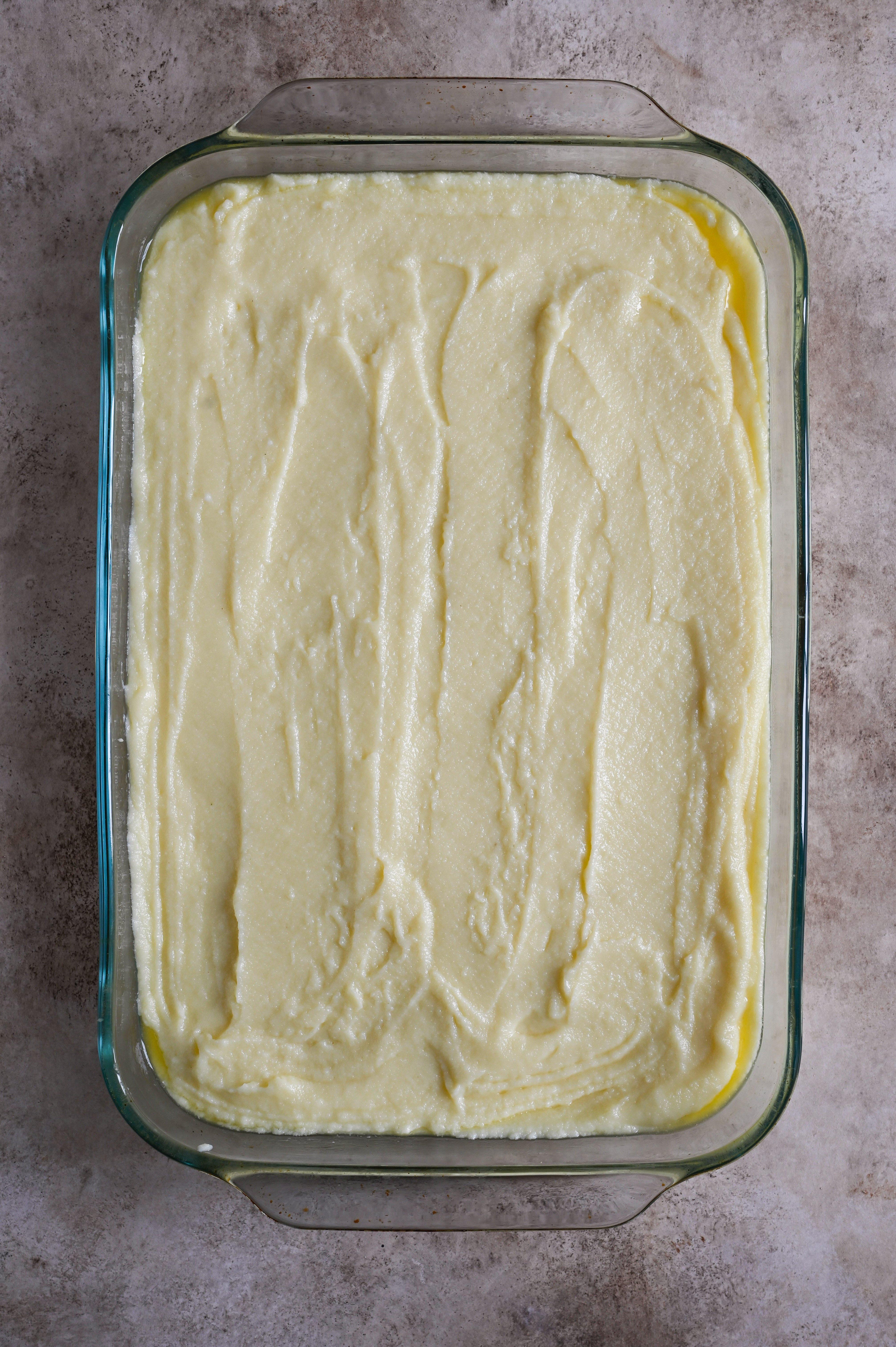

As the years passed our parents and their dear Koumbari remained the best of friends. Almost daily phone calls, frequent visits for coffee and koulourakia, and daily walks for the dads. This special relationship planted strong roots and as a result Helen baptised Alexandra’s youngest daughter, continuing the κουμπαριό for another generation!
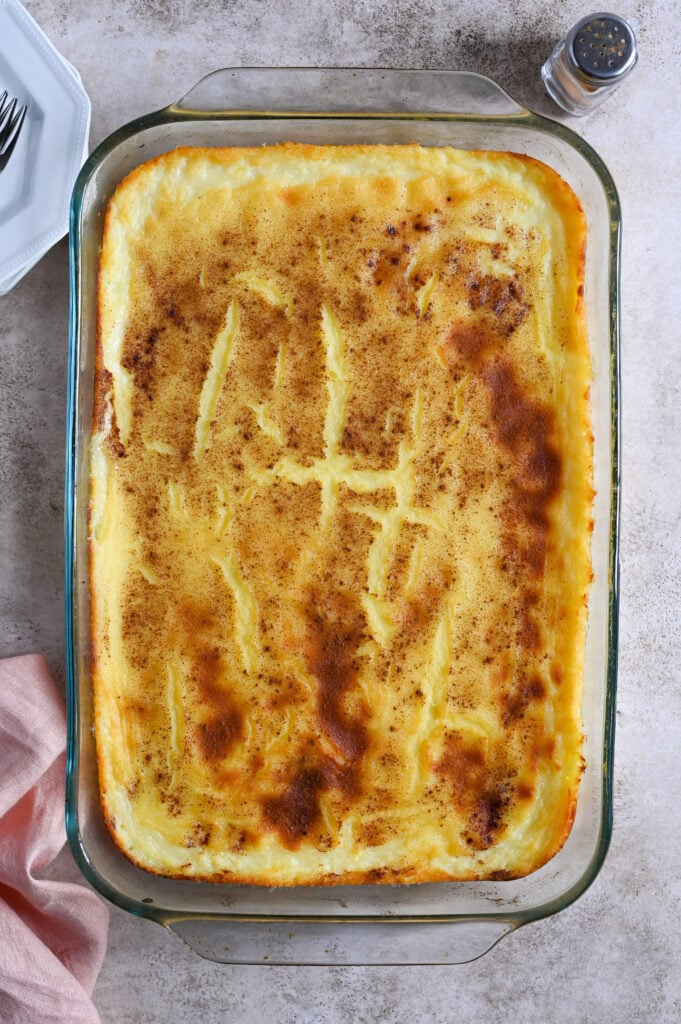
Helen’s Nouna died in December of 2020 and she is still so greatly missed. Although we had always hoped to be able to make her galatopita with her, circumstances simply didn’t allow it. We did the next best thing however. We consulted with Nouno who shared her “recipe” with us. He taste-tested our versions and sent us back to the drawing board a number of times until finally – we got it! And even before he confirmed that we were spot on, we knew we were. With our last version of galatopita, one bite took us back in time. We could see Nouna smiling her big bright smile and walking towards us with a platter of her galatopita, inviting us to eat.
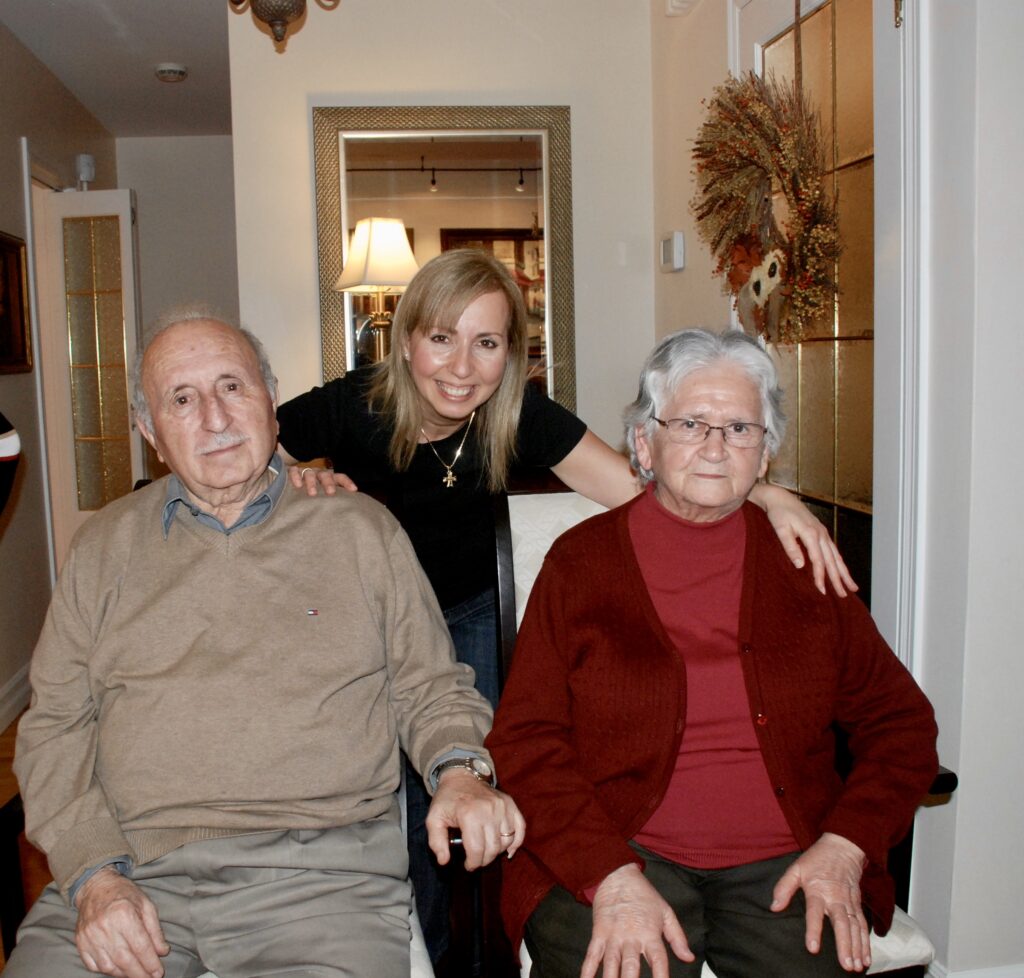
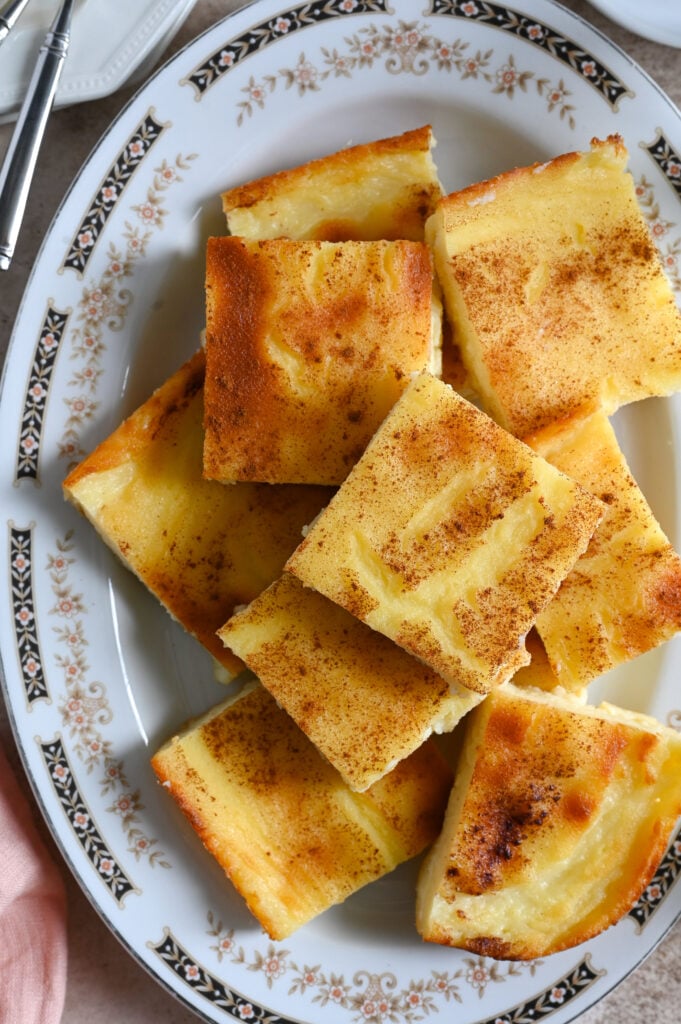
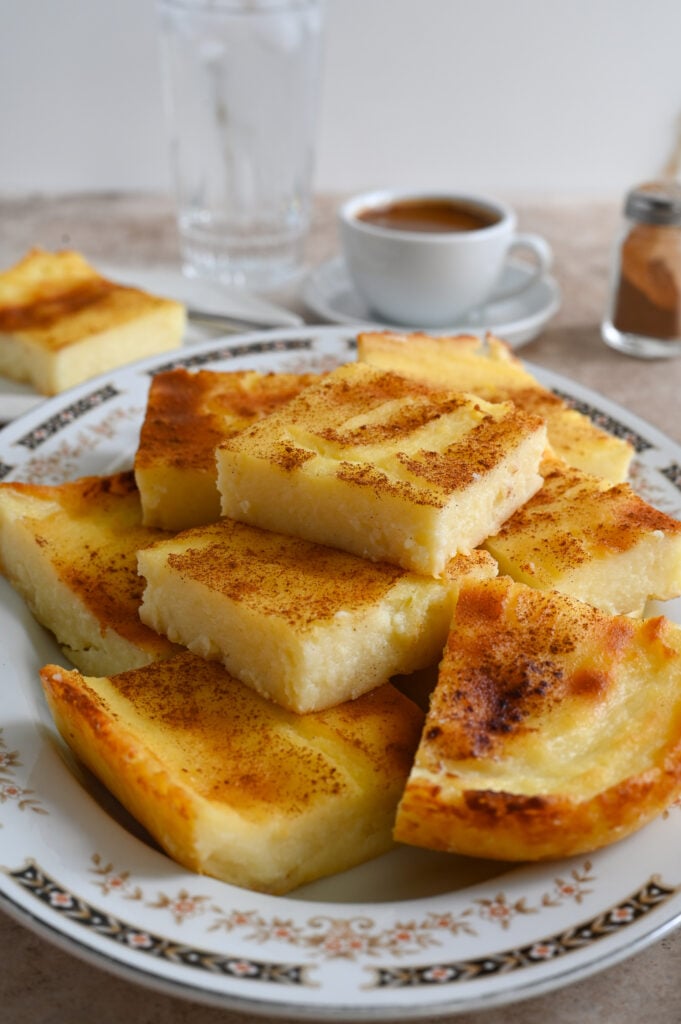
Helpful hints
What is the difference between galatopita and galaktoboureko?
First let’s start with the similarities. They both include semolina, milk and other simple ingredients and both are utterly delicious. Galaktoboureko however always includes phyllo, and galatopita only sometimes does (but typically does not). Also, galatopita is a milk custard pie that is quite firm, and can easily be eaten with your fingers. The custard in galaktoboureko, and the fact that it is soaked in syrup, typically requires a fork. The galatopita is sweetened with the sugar in the milk custard; there is no syrup added.
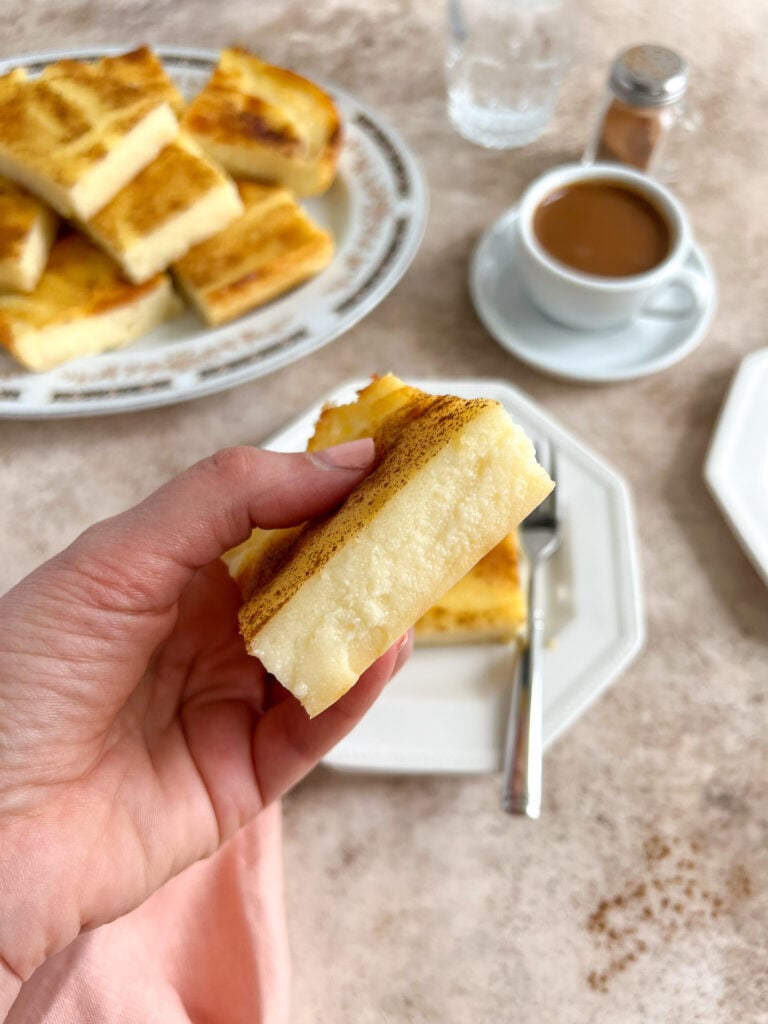
How long does galatopita, milk custard pie, last in the fridge?
Properly covered galatopita will last 3 – 5 days in the refrigerator. Chances are it won’t last that long however!
Can you make galatopita, milk custard pie, with low fat or lactose-free milk?
You can, but be prepared to have the texture and even colour differ from what you see in our photos. One of our initial versions of this dessert used lactose free milk and lactose free butter – the galatopita milk custard tasted fine but it had a grey tinge to it which was weird.
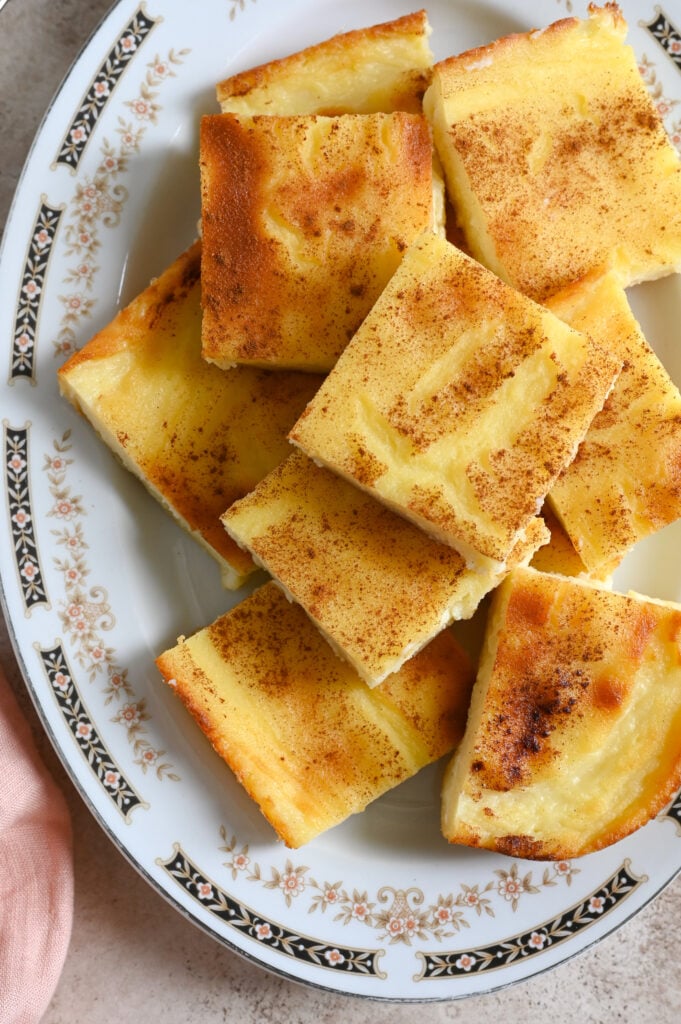
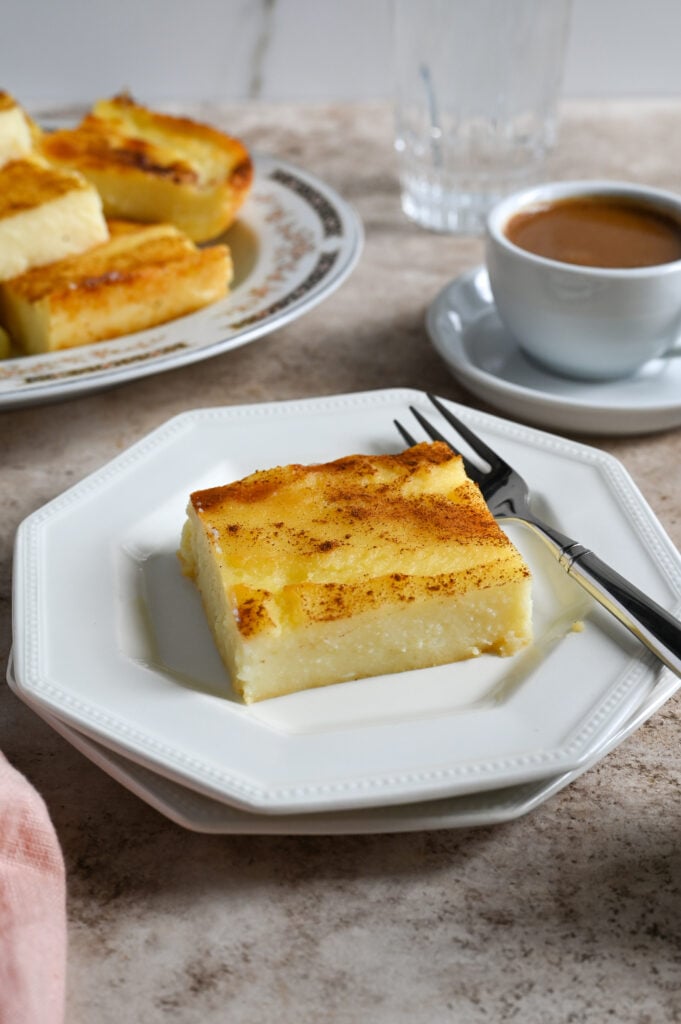
Looking for more delicious Greek recipes? Check these out:
We love hearing from you! If you have made our recipes, or if you have a question or comment, or simply want to say Hi!, please leave a comment and star rating below! Also be sure to follow along with us, on Facebook, Instagram and Pinterest. We have lots of fun over there.
This post may contain some affiliate links, which means that we make a small commission off items you purchase at no additional cost to you.
In loving memory of Helen’s godparents and best friends to our parents. The world is less sweet without you.

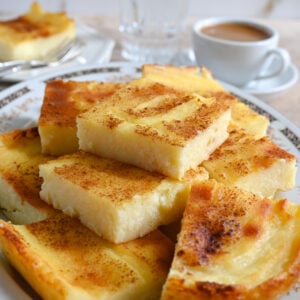
Galatopita, Greek milk custard pie
Equipment
- Glass baking pan, 10 X 15 inches
Ingredients
- 2 tbsp unsalted butter (divided)
- 1 ⅓ cups sugar
- 2 liters 2% milk see Recipe Notes
- pinch of salt
- 1 ½ cups fine semolina
- 5 eggs
- 1 teaspoon ground cinnamon
Instructions
- Preheat your oven to 350 degrees Fahrenheit.
- Place a large pot over medium heat and add 1 tablespoon of butter and melt it. Add the sugar to the pot and mix with the melted butter until combined.1 ⅓ cups sugar, 1 ½ cups fine semolina
- Slowly pour in the milk, and a pinch of salt. Slowly pour in the semolina and cook, stirring regularly, for about 5 minutes.2 liters 2% milk, pinch of salt
- Meanwhile, place the eggs in the bowl of your stand mixer (or other bowl if using a hand held mixer) and beat until the yolks and the whites are well combined. Slowly pour the beaten eggs into the pot containing the milk and semolina. At this point, you must continuously stir the contents of the pot to prevent the eggs from curdling.5 eggs
- Continue to cook, stirring constantly over medium-high heat for about 10 minutes. The custard is done when it has the consistency of pudding. Remove heat and set aside.
- Melt the remaining tablespoon of butter and spread it on the bottom and up the sides of your baking pan.
- Pour your custard into your prepared pan. Spread it out as evenly as possible using a rubber spatula, or the back of a spoon or fork.
- Sprinkle the custard generously with cinnamon.1 teaspoon ground cinnamon
- Bake your galatopita on the middle rack of your oven for about 50-60 minutes, or until the surface starts to brown. We like to transfer the galatopita to the bottom rack of our oven for the last 10 minutes of baking.
- Let your galatopita sit at room temperature for 1 hour; then place in the fridge for 2 hours, before cutting into it. This will allow the galatopita to reach the proper texture and consistency.
- Cut into square serving size pieces and enjoy slightly chilled or at room temperature. If you prefer you can also warm it up a little bit in the microwave. Leftovers should be kept in the refrigerator where they will keep for 3 - 5 days..

Thank you so much for this recipe, my dad and yaiyai have passed and I have been looking for one for Greek Easter. This has absolutely made my day.
So happy to know that Arna! We hope that you love it as much as we do and that it brings back fond food memories 🙂 Kali Anastasi! xoxo Helen & Billie
This looks tasty!
Thanks Dorothy! It’s a Greek classic…and so good! 🙂 xoxo Helen & Billie
Love following your Facebook page! What a beautiful post! So many of us can relate! Do you think gluten free flour would work in place of semolina? I would love to find ways to enjoy traditional pastries again. Thanks!
Hi Stacey! Thank you so much for your kinds words! We love that you can see yourself in our stories and recipes :). As for the gluten-free flour…we’re not sure that would work. We would actually suggest you try corn flour or polenta first – the texture is more like the semolina. We haven’t tried that either though, so not sure how it would end up. Perhaps try halving the recipe so that you don’t waste too many ingredients in case it’s a dud! Let us know if you do give this a try! xoxo Helen & Billie
I love ,love your recipes!!!This milkpie in particular brought back memories of sooooo long ago !!! My mom used to make this on Easter Sunday while we were waiting for the leg of lamb & potatoes roasting in the oven !! I had forgotten all about it . But I will make it first thing in the morning & serve it on Easter Sunday with our leg of lamb & potatoes & dyed eggs of course .Thank you so much ladies ,wishing you a blessed & happy Easter!! God bless !!
Vicky your message has really warmed our hearts. It truly means so much to us that we were able to bring back fond memories. We hope that you and your family love the galatopita. Kali Anastasi! xoxo Helen & Billie
That looks delicious. I was looking at the photos
Thanks for sharing…!!!! You can check also our products on https://fusiongifts.in/
Now THAT is what I have been looking for!!!!!
Thank you..!!!!You can check also our products on https://fusiongifts.in/
Amazing! Hope you enjoy it 🙂 xoxo Helen & Billie
Can you add vanilla extract to this recipe? If so would 1.5 tsp. Be good? Thank you!
Hi Evy! You can certainly add some vanilla extract if you like. We would recommend starting with 1 teaspoon at most – you don’t want the vanilla flavour to be overpowering. The galatopita should taste milky! Enjoy, we hope you love it! xoxo Helen & Billie